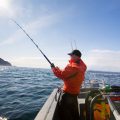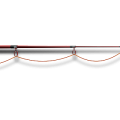
Getting fish to bite the bait and stay on the hook successfully is what separates novice fishermen from amateurs. Knowing how to bait a fishing line is among the basics of fishing. If you are always finding fishing difficult, then chances are your bait isn’t properly placed.
One common mistake most fisherman do is placing the bait in a position that the fish can
take a bite and still go about its business. Attaching bait is a simple
procedure but plays a significant role in fishing. Below is a step by step
guide that will teach you how to bait a fishing line.
Step 1: Choose The Right Hook
Baiting involves more than just placing a worm on a hook. The type of hook used matters
a lot. An ideal hook should have a well-pointed end that will guarantee trapping
the fish’s mouth when it takes a bite. You can choose the single, double or
treble hook. We mostly recommend the treble since it increases the chance of
you catching as many fish as possible.
However, if you decide to use live bait, you should use a single hook at the end of your
fishing line. Double hooks, on the other hand, works best on artificial lures.
Also, the type of hook you use to bait a fish should depend on the size of fish you
intend to catch. You can use an Aberdeen hook on small fish and bait holder
hooks for leeches and grubs.
Step 2: Identify a Suitable Sinker
For the bait to attract fish, it must be at the ideal length in the water. No matter the
type of fishing line you use. On its own, it can’t reach the ideal depth of
where most fish swim. A sinker can help you with this. You can opt for a
pyramid or bullet sinker.
Moreover, you should choose one that is made of tungsten or steel. These two are
environmentally friendly, unlike lead. With the appropriate sinker, you can be
assured that your bait will reach the soft waters beneath. Note that, sinkers
aren’t ideal when fishing with heavy live-baits and artificial lures.
Step 3: A Bobber also Comes in Handy
Bobbers also play a significant role in baiting a fish line. They act as an indicator as to
whether the fish has taken the bait and if it is being pulled underwater. A
fishing line that lacks a bobber makes it difficult to know if the bait has
caught something back. Round bobbers are the most common type used. Before
throwing the fishing line to the water, always ensure the bobber is correctly
connected to the fishing line.
Step 4: Use a Clinch Knot or a Uni-Knot to Tie The Hook to The Fishing Line
Most big fish can overpower a hook if it has not been tied on to the fishing line with a strong knot. This, therefore, implies the knot tied on to a hook does play a significant role. When it comes to tying a hook to the fishing line, we recommend you use either the clinch or uni-knot.
The clinch knot entails threading the line through the hook for at least 15 cm then
wrapping the tag end. And fold the line back on itself in a loop. The uni-knot,
on the other hand, entails forming a loop by wrapping the line through the hook
with double lines. Do this six times and finalize by wrapping the tag end.
Step 5: Use Live or Dead Bait
Contrary to the opinion of most people, live bait is more effective than dead bait. Fish
are used to feeding on other live organisms. Therefore, using dead bait can
result in fish being skeptical about taking a bite from your bait.
Nonetheless, the bait used depends on what you have available. If you have dead bait, you
can proceed with using it. To those who intend on using live bait, the big
question always is how to attach live bait to the fishing line and still keep
it alive? Well, it’s quite simple. The key is to avoid hooking the bait on its
vital components such as the head or spine. This will ensure it stays alive for
long enough.
Step 6: Go Fishing
With the above tips on how to bait a fishing line, you are now ready to go fishing.
Whether you opt to use worms, crabs or insects, knowing how to bait a fishing
line is vital. The above are all elements that will ensure your bait is
appropriately placed on the fishing line and you are ready to use your rod and reel.











